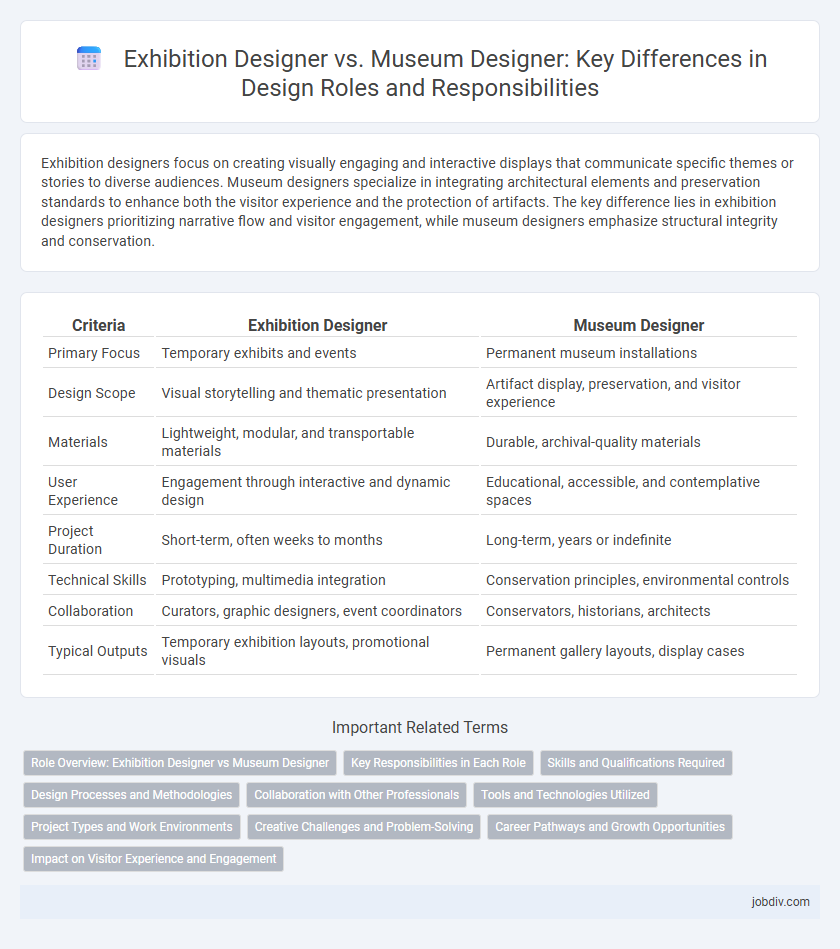Exhibition designers focus on creating visually engaging and interactive displays that communicate specific themes or stories to diverse audiences. Museum designers specialize in integrating architectural elements and preservation standards to enhance both the visitor experience and the protection of artifacts. The key difference lies in exhibition designers prioritizing narrative flow and visitor engagement, while museum designers emphasize structural integrity and conservation.
Table of Comparison
| Criteria | Exhibition Designer | Museum Designer |
|---|---|---|
| Primary Focus | Temporary exhibits and events | Permanent museum installations |
| Design Scope | Visual storytelling and thematic presentation | Artifact display, preservation, and visitor experience |
| Materials | Lightweight, modular, and transportable materials | Durable, archival-quality materials |
| User Experience | Engagement through interactive and dynamic design | Educational, accessible, and contemplative spaces |
| Project Duration | Short-term, often weeks to months | Long-term, years or indefinite |
| Technical Skills | Prototyping, multimedia integration | Conservation principles, environmental controls |
| Collaboration | Curators, graphic designers, event coordinators | Conservators, historians, architects |
| Typical Outputs | Temporary exhibition layouts, promotional visuals | Permanent gallery layouts, display cases |
Role Overview: Exhibition Designer vs Museum Designer
Exhibition designers specialize in creating visually compelling and interactive displays tailored to specific events or themes, emphasizing audience engagement and spatial flow. Museum designers focus on long-term installations that preserve artifacts while balancing educational storytelling with visitor accessibility and conservation standards. Both roles require collaboration with curators, architects, and lighting experts to develop immersive environments that communicate narratives effectively.
Key Responsibilities in Each Role
Exhibition designers specialize in creating engaging, immersive displays that communicate a specific theme or message, integrating visual graphics, lighting, and spatial arrangement to enhance visitor interaction. Museum designers focus on preserving and presenting historical or valuable artifacts with attention to conservation requirements, accessibility standards, and educational storytelling through exhibit layout. Both roles require collaboration with curators and stakeholders but differ in their primary emphasis on creative expression versus preservation and educational impact.
Skills and Qualifications Required
Exhibition designers require expertise in spatial planning, graphic design, and interactive media to create engaging displays that communicate specific themes or products. Museum designers must possess strong knowledge of artifact preservation, historical context, and interpretive storytelling to design exhibits that educate and protect collections. Both roles demand proficiency in CAD software, project management, and collaboration with curators, but museum designers often need advanced degrees in museum studies or history.
Design Processes and Methodologies
Exhibition designers concentrate on creating immersive and interactive environments that engage diverse audiences through storytelling, spatial arrangement, and multimedia integration, emphasizing visitor experience and adaptability. Museum designers prioritize preservation, educational value, and accessibility, developing layouts and displays that balance artifact protection with clear interpretive messaging. Both roles utilize user-centered design methodologies, collaborative stakeholder input, and iterative prototyping, but exhibition design methods often incorporate experiential innovation while museum design demands rigorous adherence to conservation standards.
Collaboration with Other Professionals
Exhibition designers collaborate closely with curators, graphic designers, and lighting experts to create immersive and engaging visitor experiences that effectively communicate the exhibit's theme. Museum designers work alongside architects, conservators, and accessibility specialists to ensure the preservation of artifacts while maintaining functional and inclusive spaces. Both roles require seamless teamwork with interdisciplinary professionals to balance aesthetic appeal, educational value, and practical constraints.
Tools and Technologies Utilized
Exhibition designers leverage advanced 3D modeling software such as AutoCAD, SketchUp, and Rhino to create immersive and interactive spaces, while also incorporating AR and VR technologies to enhance visitor engagement. Museum designers focus heavily on lighting control systems, climate monitoring tools, and conservation-grade display materials to ensure artifact preservation and optimal viewing conditions. Both roles utilize project management platforms like Trello and BIM software, but museum designers prioritize technologies that balance aesthetic presentation with stringent preservation requirements.
Project Types and Work Environments
Exhibition designers typically work on temporary displays for events, trade shows, or retail spaces, focusing on visual impact and visitor engagement in dynamic, changing environments. Museum designers specialize in creating permanent or semi-permanent installations that emphasize historical accuracy, preservation, and educational storytelling within controlled settings. Both roles require collaboration with curators and architects but differ in project duration, scale, and the balance between creativity and conservation.
Creative Challenges and Problem-Solving
Exhibition designers face creative challenges in crafting immersive, thematic experiences that engage diverse audiences while meeting spatial and technical constraints. Museum designers confront unique problem-solving tasks involving artifact preservation, accessibility compliance, and integrating interactive technology without compromising historical integrity. Both roles demand innovative solutions to balance artistic vision with practical limitations in dynamic cultural environments.
Career Pathways and Growth Opportunities
Exhibition designers focus on creating engaging, thematic displays for various events or temporary installations, often emphasizing creativity and adaptability in diverse environments. Museum designers specialize in permanent or long-term exhibits, with career pathways involving expertise in historical accuracy, curatorial collaboration, and conservation considerations. Growth opportunities for exhibition designers include roles in event management or retail design, while museum designers may advance to senior curatorial or collections management positions.
Impact on Visitor Experience and Engagement
Exhibition designers create immersive displays that prioritize storytelling and interaction, enhancing visitor engagement through dynamic layouts and multimedia elements. Museum designers integrate architectural and curatorial principles to ensure the space facilitates both education and emotional connection. The collaboration between these roles determines how effectively visitors absorb information and connect with exhibits.
Exhibition Designer vs Museum Designer Infographic

 jobdiv.com
jobdiv.com